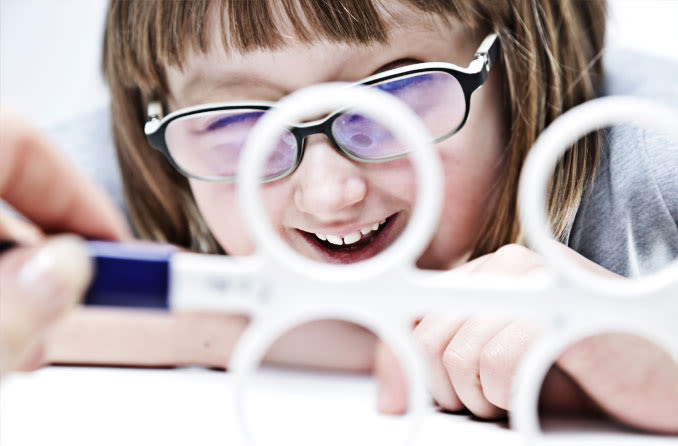Vision therapy for children: When glasses aren’t enough

Vision therapy is perhaps one of the most controversial topics in vision care.
Some eye doctors are strong advocates for vision therapy and testify to its benefits — especially for certain vision problems of children. But other eye doctors are not convinced of vision therapy's effectiveness and do not recommend it.
This article will help you learn more about vision therapy so you can make an informed decision regarding its potential benefits for your child.
What is vision therapy?
Vision therapy is a doctor-supervised, non-surgical and customized program of visual activities designed to correct certain vision problems and/or improve visual skills.
Unlike eyeglasses and contact lenses, which simply compensate for vision problems, or eye surgery that alters the anatomy of the eye or surrounding muscles, vision therapy aims to "teach" the visual system to correct itself.
Vision therapy is like physical therapy for the visual system, including the eyes and the parts of the brain that control vision.
Vision therapy can include the use of lenses, prisms, filters and computer-assisted visual activities. Other devices, such as balance boards, metronomes and non-computerized visual instruments also can play an important role in a customized vision therapy program.
It is important to note that vision therapy is not defined by a simple list of tools and techniques. Successful vision therapy outcomes are achieved through a therapeutic process that depends on the active engagement of the prescribing doctor, the vision therapist, the patient and (in the case of children) the child's parents.
Overall, the goal of vision therapy is to treat vision problems that cannot be treated successfully with eyeglasses, contact lenses and/or surgery alone, and help people achieve clear, comfortable binocular vision.
Many studies have shown that vision therapy can correct vision problems that interfere with efficient reading among schoolchildren. It also can help reduce eye strain and other symptoms of computer vision syndrome experienced by many children and adults. See below for more on conditions treated with vision therapy.
SEE RELATED: Eye and vision problems in preschool children
Orthoptics and vision therapy
Vision therapy is sometimes called visual therapy, vision training, visual training or simply "VT."

Vision therapy can correct vision problems that interfere with efficient reading.
Another name often associated with vision therapy is "orthoptics." This term, which literally means "straightening the eyes," dates back to the 1850s and is limited to techniques for training eye muscles for the purpose of cosmetically straightening eyes that are misaligned due to strabismus.
Orthoptics can be very successful and is one type of vision training, but the term "orthoptics" is not synonymous with "vision therapy," which describes a broader range of techniques used to treat a wider variety of vision problems.
Also, whereas the emphasis in orthoptics is on eye muscles and eye alignment (at least cosmetically), the goal of vision therapy is to optimize the entire visual system, including the eyes and areas of the brain that control vision, visual perception and other vision-related functions.
By treating the entire visual system, vision therapy aims to change reflexive (automatic) behaviors to produce a lasting cure.
In many cases of strabismus, vision therapy can be a better treatment choice than surgery. In other cases, it can be a beneficial adjunct therapy before and after surgery to increase the likelihood of a successful outcome.
The science behind vision therapy
You've probably heard the old adage, "You can't teach an old dog new tricks."
But recent research in the field of neurology suggests that when it comes to the human brain, that's not true. It just may take a little more time and effort.

Vision therapy and sports vision training can improve vision skills needed for sports.
Studies show that the human brain has a significant amount of neuroplasticity — the ability to change its structure and function in response to external stimuli. And these neurological changes in the brain, once thought to occur only during early childhood, have been demonstrated to occur in adults as well.
In one study, for example, experienced adult typists who underwent long-term training to improve their keyboarding skills demonstrated increases in gray matter volume in their brains, suggesting that learning affects not only function, but also brain structure.
Recent findings about neuroplasticity appear to confirm what many vision therapy experts have been saying for years: properly devised and administered programs of VT can cause neurological changes that can correct vision problems and improve visual performance.
Some experts say certain anomalies associated with vision development, visual perception or vision function may be affected by neuroplasticity. If this is true, it's likely these same vision problems may be successfully treated with vision therapy.
Problems vision therapy can correct
Vision therapy can relieve symptoms and improve outcomes for a variety of vision problems, including:
Amblyopia. Also called "lazy eye," amblyopia is a vision development problem where an eye fails to attain normal visual acuity, usually due to strabismus or other problems of eye teaming.
Strabismus. The success of vision therapy for strabismus depends on the direction, magnitude and frequency of the eye turn. VT has been proven effective for treating an intermittent form of strabismus called convergence insufficiency, which is an inability to keep the eyes properly aligned when reading despite good eye alignment when looking at distant objects.
Other binocular vision problems. Subtle eye alignment problems called phorias that may not produce a visible eye turn but still can cause eye strain and eye fatigue when reading also can be minimized or corrected with vision therapy.
Eye movement disorders. Studies have shown vision therapy can improve the accuracy of eye movements used during reading and other close-up work.
Accommodative (focusing) disorders. Other research shows near-far focusing skills can be improved with vision training.
Other problems. Other vision problems for which vision therapy may be effective include visual-perceptual disorders, vision problems associated with developmental disabilities and vision problems associated with acquired brain injury (such as from a stroke).
What vision therapy isn't
It is important not to mistake vision therapy for self-help vision improvement programs advertised online and on television that promise you can "throw away your glasses" after performing a series of eye exercises.
There is no scientific research that supports the claim that these self-help programs of eye exercises can reverse nearsightedness or other refractive errors.
It's also important to know that a home-based regimen of "pencil push-ups," even when recommended by an eye doctor, should not be considered a complete program of vision therapy.
Pencil push-ups — an orthoptic activity in which a person looks at small print on a pencil held at arm's length, and then slowly moves the pencil closer to his or her eyes while maintaining focus on the letters — is a task sometimes recommended for people to perform at home to decrease eye strain and other symptoms caused by convergence insufficiency (CI).
A study published in Archives of Ophthalmology found that a home-based regimen of pencil push-ups was ineffective for CI among children with the condition. The same study found that a 12-week program of supervised, in-office vision therapy plus orthoptics produced a functional cure of convergence insufficiency in over half the age-matched children with CI who received this treatment.
A follow-up study revealed that among 221 children ages 9 to 17 years with symptomatic convergence insufficiency, 73 percent receiving office-based vision therapy combined with home exercises had successful or improved outcomes, compared with 43 percent of those who performed pencil push-up exercises at home.
While a well-intentioned eye doctor may recommend pencil push-ups at home (with or without follow-up visits to monitor progress) as a low-cost treatment for convergence insufficiency, these studies suggest a supervised in-office program of vision therapy plus reinforcement orthoptic exercises performed at home is the most effective non-surgical treatment for this vision problem.
Sports vision training
Sports vision training is not vision therapy, but it shares some of the characteristics of VT. Eye doctors who specialize in sports vision offer customized vision training programs for anyone interested in optimizing their visual skills for specific sports.
Many Olympic and professional athletes have undergone sports vision training programs to improve their performance.
Because sports vision training programs typically are designed to enhance a person's visual skills for a specific sport rather than to correct a vision problem, the term "vision training" is preferred over "vision therapy." However, some of the techniques used in sports vision training are similar to those used in vision therapy.
NEED AN EYE TEST? Find an optician near you and schedule an appointment.
Page published on Friday, 28 June 2019






